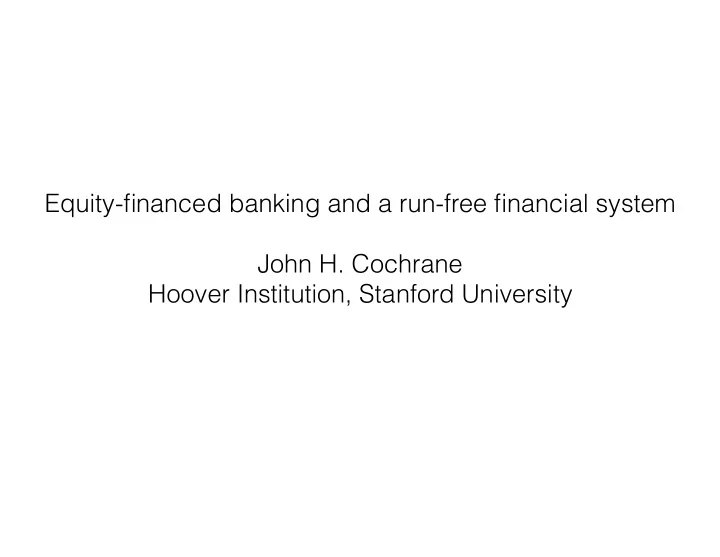

Equity-financed banking and a run-free financial system John H. Cochrane Hoover Institution, Stanford University
Principle • Name, diagnose, and limit the problem before you start fixing Premises • Goal: End financial crises. Period. • Not: End to big to fail per se. • Financial crisis = systemic run. • Not: Dominoes. Outsized losses. Dark ATMs. Holes in ground. • Stock crashes = good. (Or at least not our problem.) Vision before regulation • Central problem: run-prone liabilities • Answer: no more large-scale funding by run-prone liabilities! • “Banks” finance their risky asset holdings with equity, (+long-term debt). • Fixed-value “deposits”-> reserves, treasuries.
But how will banks make loans? $10 Equity (stock) $100 $100 Assets (1) Bank People (complex) $90 Debt (deposits, bonds) $100 Equity $100 $100 Assets (2) Bank (very safe!) People (complex) (diversified) (3) $10 Equity $100 $100 Assets $100 Mutual fund, Bank People (complex) Equity Holding co. $90 Debt (diversified) • Eliminating financial crises with 100% equity financed banking does not require any new money, any less credit or any additional risk taking
A more realistic structure (4) $30 Mutual fund, ETF Securitized debt $100 $40 Assets $40 Equity Bank Mutual fund, ETF People (complex) (safe!) $30 fixed Reserves Transactions value Provider debt $14T Treasury debt (Floaters?)
Getting there Remove disincentives/bad regs first! • Tax distortion • Debt guarantees • Regulations that encourage holding debt • Capital gains tax • Short term debt is poison in the well! • Regulatory safe harbor Finally, a bit of stick: • Not ratios, risk weights, etc. • Pigouvian tax on debt, say 5 cents/ dollar • Higher for high debt / market value of equity
Before you complain • Costs and dysfunction of the current system. • Current regulation lost in the woods. • High hurdle for whining!
Recommend
More recommend